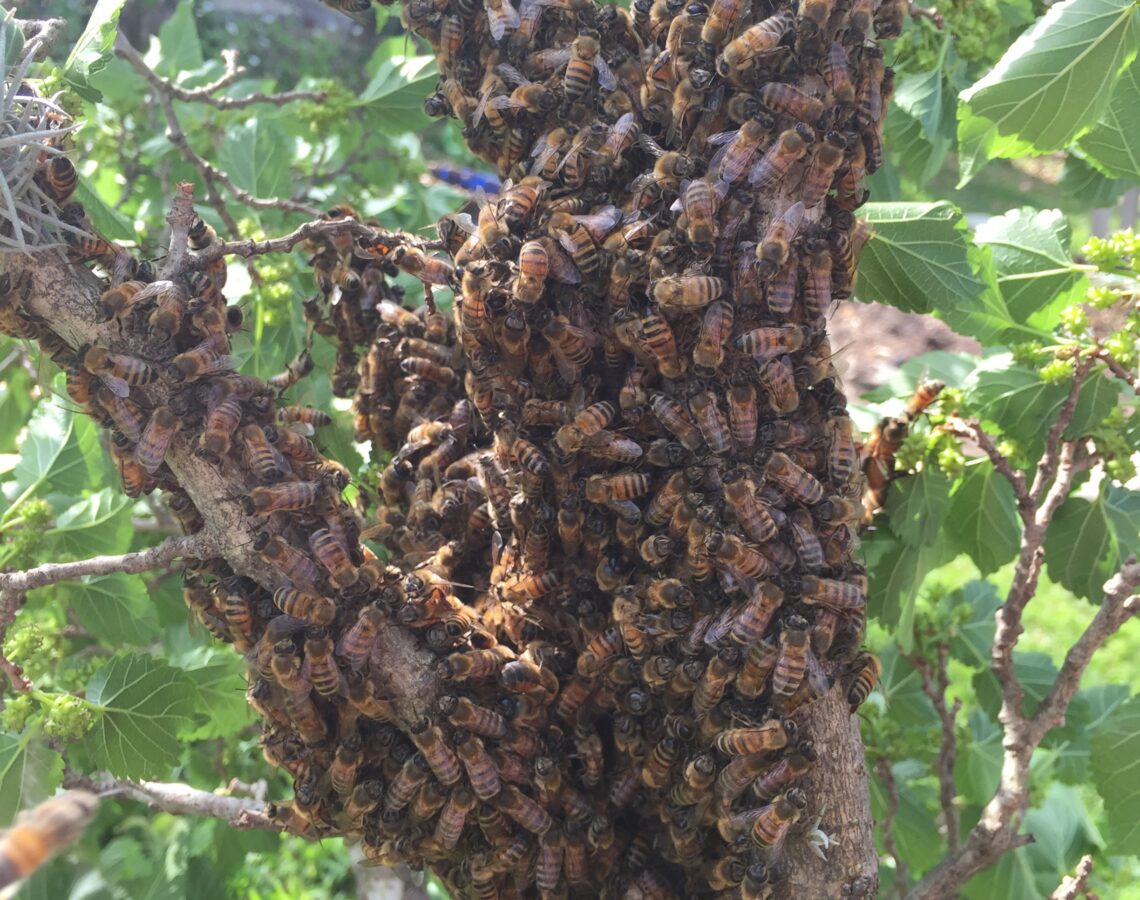Let’s Talk Swarming

The term “swarming” is probably the most misused term related to honey bees and beekeeping. Swarming does not refer to attacking bees. And swarming is not what a hive does when it’s unhappy with its abode (that is actually called absconsion!) Swarming is, simply put, the colony’s way of reproducing. Colonies can spread their genetics two ways: by producing drones who will mate with virgin queens from other hives and by swarming.
Rather than think of the individual bees in a colony as discrete organisms, we need to think of the colony as a whole as the organism. And like all living beings, this organism needs to reproduce. The mere mention of a swarm can simultaneously put fear and excitement in the heart of a beekeeper! Most beekeepers would prefer that their own bees not swarm, but catching another colony’s swarm can mean “free bees!” Let’s learn the ins and outs of how a colony swarms so that you can learn how to help prevent swarming in your own apiary and maybe even catch your own swarm or two someday.
How One Colony Can Become Two
When nutritional resources and a robust healthy queen allow, a hive can grow to be so large and packed with bees that it can then split into two or more colonies. The mechanics of this split is fascinating. As a colony grows and congestion in the hive occurs, and if enough honey resources are available, it signals to the workers that the hive is strong enough to swarm. Also, if the queen starts to run out of space to lay eggs, either naturally or because of misguided decision-making and interventions by the beekeeper, this can also signal the colony to swarm.
Once the hive has decided to swarm, the workers will prepare for this monumental event by stuffing themselves full of honey to take on their journey. The queen bee, meanwhile, stops laying eggs and is put on a diet by the worker bees. This diet decreases her body weight and allows her to fly with the swarm. On the fateful day, one-third to one-half of the young worker bees will leave the colony en masse with the queen. This, the swarm, is looking for a new home to start a new colony. If you’ve never had the opportunity to see this amazing sight, a swarm of bees looks like a big cloud of insects moving across the sky.
When the swarm leaves the hive, they have not yet selected a new hive site, so they will find a place to rest and to give foraging bees, called scout bees, the opportunity to hunt for new real estate. The swarm will rest in a tight ball, with the queen protected at the center. This swarm may rest on a tree, a fenceline, a car, or even your mailbox! Once settled, scout bees will begin flying from the swarm, looking for a suitable home. They will return to the swarm and perform the same waggle dance that they use to communicate the location of food to communicate the location of a new potential home. Each of the scout bees will visit all of the potential homes, then return to the swarm and ‘vote’ for their favorite by performing this dance. When all of the scouts are performing the same dance and are in agreement, the entire swarm will move once again–this time to their new home. This house hunting can take as little as a few hours or as long as a few days. The bees that have engorged themselves with honey will immediately begin to use the carbohydrates to build the beeswax comb so the queen can again start to lay eggs and establish the new colony.
In many ways, a swarm is a colony’s dream, as it means that the colony has been successful enough to reproduce. But as beekeepers, we tend to want to keep our bees in our own apiaries, instead of losing honey stores and a healthy, productive queen to a swarm that will establish itself elsewhere. So as spring finally reaches us after a cold winter, keep an eye on your hives’ population and make sure your queens have adequate space to lay in the brood nest, as you may find that your strongest colonies are itching to cast a swarm.
For those of you looking for more in-depth swarm management techniques, we offer a class every spring on making nucs and splits at our honey ranch just outside of Austin–this spring’s class will be on May 7. And if you’ve caught a swarm and have a great story to share, will you leave a comment and tell me about it? Swarming stories are my favorite, and I’m always looking for new ones to share with students!
Want to receive more beekeeping tips in your inbox? Sign up for our newsletter! Be sure to check the box indicating you are interested in beekeeping tutorials and videos to receive our monthly Honey Hotline newsletter, geared towards beekeepers and wannabe beekeepers!



Leave a Reply